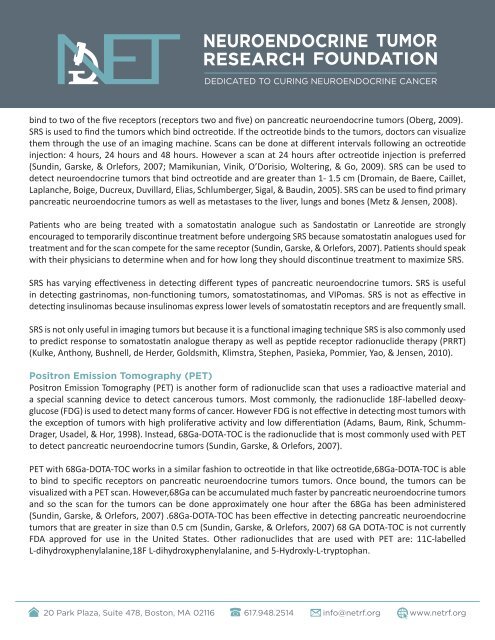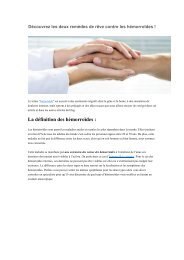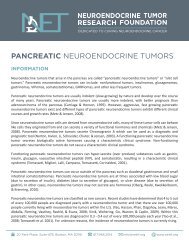PANCREATIC NEUROENDOCRINE TUMORS
You also want an ePaper? Increase the reach of your titles
YUMPU automatically turns print PDFs into web optimized ePapers that Google loves.
ind to two of the five receptors (receptors two and five) on pancreatic neuroendocrine tumors (Oberg, 2009).<br />
SRS is used to find the tumors which bind octreotide. If the octreotide binds to the tumors, doctors can visualize<br />
them through the use of an imaging machine. Scans can be done at different intervals following an octreotide<br />
injection: 4 hours, 24 hours and 48 hours. However a scan at 24 hours after octreotide injection is preferred<br />
(Sundin, Garske, & Orlefors, 2007; Mamikunian, Vinik, O’Dorisio, Woltering, & Go, 2009). SRS can be used to<br />
detect neuroendocrine tumors that bind octreotide and are greater than 1- 1.5 cm (Dromain, de Baere, Caillet,<br />
Laplanche, Boige, Ducreux, Duvillard, Elias, Schlumberger, Sigal, & Baudin, 2005). SRS can be used to find primary<br />
pancreatic neuroendocrine tumors as well as metastases to the liver, lungs and bones (Metz & Jensen, 2008).<br />
Patients who are being treated with a somatostatin analogue such as Sandostatin or Lanreotide are strongly<br />
encouraged to temporarily discontinue treatment before undergoing SRS because somatostatin analogues used for<br />
treatment and for the scan compete for the same receptor (Sundin, Garske, & Orlefors, 2007). Patients should speak<br />
with their physicians to determine when and for how long they should discontinue treatment to maximize SRS.<br />
SRS has varying effectiveness in detecting different types of pancreatic neuroendocrine tumors. SRS is useful<br />
in detecting gastrinomas, non-functioning tumors, somatostatinomas, and VIPomas. SRS is not as effective in<br />
detecting insulinomas because insulinomas express lower levels of somatostatin receptors and are frequently small.<br />
SRS is not only useful in imaging tumors but because it is a functional imaging technique SRS is also commonly used<br />
to predict response to somatostatin analogue therapy as well as peptide receptor radionuclide therapy (PRRT)<br />
(Kulke, Anthony, Bushnell, de Herder, Goldsmith, Klimstra, Stephen, Pasieka, Pommier, Yao, & Jensen, 2010).<br />
Positron Emission Tomography (PET)<br />
Positron Emission Tomography (PET) is another form of radionuclide scan that uses a radioactive material and<br />
a special scanning device to detect cancerous tumors. Most commonly, the radionuclide 18F-labelled deoxyglucose<br />
(FDG) is used to detect many forms of cancer. However FDG is not effective in detecting most tumors with<br />
the exception of tumors with high proliferative activity and low differentiation (Adams, Baum, Rink, Schumm-<br />
Drager, Usadel, & Hor, 1998). Instead, 68Ga-DOTA-TOC is the radionuclide that is most commonly used with PET<br />
to detect pancreatic neuroendocrine tumors (Sundin, Garske, & Orlefors, 2007).<br />
PET with 68Ga-DOTA-TOC works in a similar fashion to octreotide in that like octreotide,68Ga-DOTA-TOC is able<br />
to bind to specific receptors on pancreatic neuroendocrine tumors tumors. Once bound, the tumors can be<br />
visualized with a PET scan. However,68Ga can be accumulated much faster by pancreatic neuroendocrine tumors<br />
and so the scan for the tumors can be done approximately one hour after the 68Ga has been administered<br />
(Sundin, Garske, & Orlefors, 2007) .68Ga-DOTA-TOC has been effective in detecting pancreatic neuroendocrine<br />
tumors that are greater in size than 0.5 cm (Sundin, Garske, & Orlefors, 2007) 68 GA DOTA-TOC is not currently<br />
FDA approved for use in the United States. Other radionuclides that are used with PET are: 11C-labelled<br />
L-dihydroxyphenylalanine,18F L-dihydroxyphenylalanine, and 5-Hydroxly-L-tryptophan.<br />
20 Park Plaza, Suite 478, Boston, MA 02116 617.948.2514 info@netrf.org www.netrf.org
















